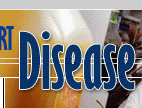Click here to go back.
REPLACING ANIMALS IN HEART DISEASE RESEARCH
Since animals do not naturally develop most human cardiovascular diseases, it makes sense to replace the animals in these experiments with accurate methodologies. Unlike animal-based experiments, non-animal research methods provide legitimate, valid results that can be accurately applied to humans.
No gain has been made by any experiments on animals. Any successful procedures or drugs were obtained through non-animal means.
Clinical research (the observation and analysis of a patient’s condition) and epidemiology (the study of disease within a human population) remain the most important methods of learning about heart disease and are vital to any such progress. The most noteworthy example is the immensely valuable Framingham study, which resulted in a landmark breakthrough in medicine. By studying Framingham, MA residents’ lifestyles, scientists firmly and indisputably established the link between coronary artery disease and hypertension, smoking, and high fat diets. This study paved the way for many other cardiovascular discoveries, including the identification of HDL and LDL as good and bad cholesterols, age and gender effects, and the risk factors of obesity, diabetes and physical inactivity.
Nonetheless, there were those who wanted to “validate” these results in animals, no doubt encouraged by the grant money available. These experiments failed, time and again, with rabbits, bears, dogs, cats, rats, kangaroos, seals, sea lions, pelicans, monkeys, chimpanzees, baboons, gorillas, pigs, horses, parrots, ducks and chickens, none of whom formed artery plaques similar to humans.
Fortunately, the Framingham study is now in its third generation and still considered essential in understanding heart diseases. These researchers make use of new technologies, such as echocardiography, carotid artery ultrasound, bone densitometry and computerized tomography, along with tried and true clinical observation. This approach has resulted in crucial human data that have led to effective treatments and preventative strategies.
Clinical research has also revealed a gene linked directly to heart attacks; the correlation between high HDL levels (the good cholesterol) with long life and higher cognitive ability; the ability to avoid and even reverse blockages in arteries with exercise, weight loss, a low fat, vegetarian diet, decrease in stress, lack of smoking and high doses of vitamin B6. Clearly, clinical research has been absolutely vital to medical advancements.
In order to teach surgical techniques, many medical schools have discontinued live animal surgeries and instead bring their students into hospital operating rooms to observe. They employ CD-roms, such as “Physiology Labs” which allow pupils to interactively navigate through cardiovascular physiology and experiment with various factors. Autopsies provide invaluable instruction in surgical techniques. They have played a part in heart disease research for centuries, providing vital information about disease processes. Unfortunately, they are rarely performed due to high expenses, but if only one of five patients was autopsied, significant data would be collected.
In vitro research is conducted in a controlled, relevant environment, using human cells, blood and tissues. Most health problems occur at the microscopic, cellular level, which makes in vitro ideal for cardiovascular research. Penicillin and streptomycin were discovered through this method. Since the tests are human-based, any conclusions can be accurately applied to human use. In vitro research is effective, safe, scientifically validated, less costly and more productive than animal-based tests.
Post-marketing drug surveillance is an effective but underused tool to determine a medication’s effect on humans. Adverse reactions can be easily detected and therefore avoided, potentially saving lives. This system of reporting all effects and side effects of a drug can also increase the chances of finding new uses for existing drugs. This practice is unfortunately not mandatory, but if the medical industry would implement this policy, valuable information would be quickly gathered, sparing human harm and death.








